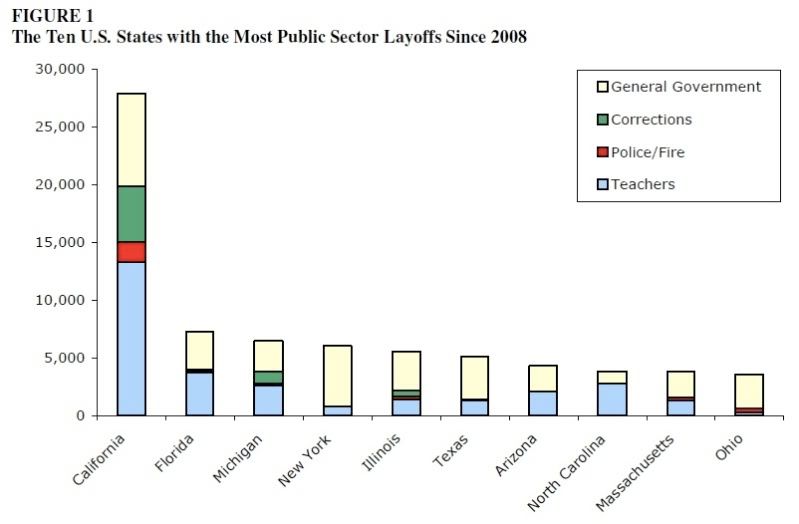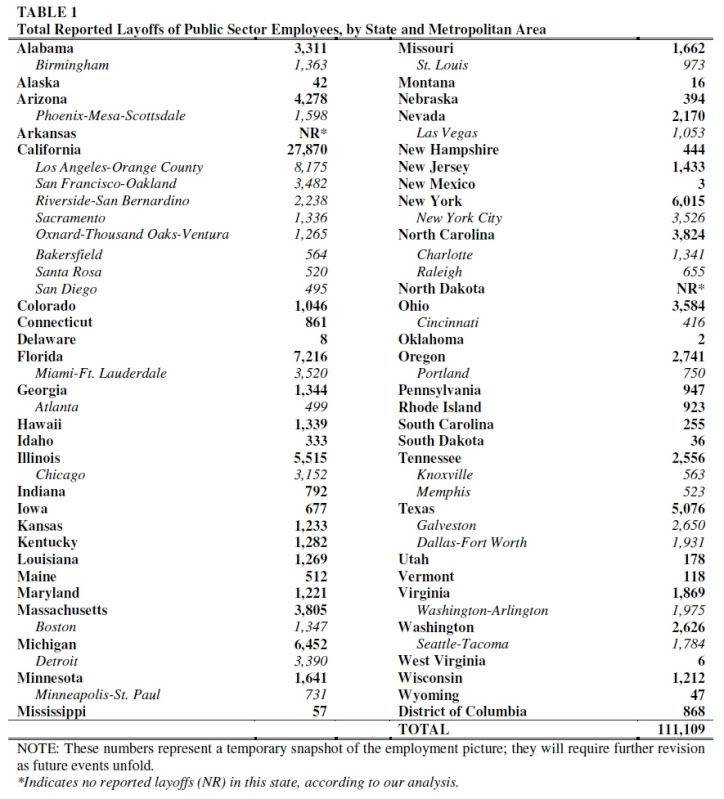In the current recession, millions of Americans have lost their jobs. Unemployment has increased nationwide to levels not witnessed since the 1980s. Much of the job loss has occurred in private industries, but the public sector has also felt the sting of layoffs. Decreasing tax revenues and expanding budget deficits have forced public officials to make difficult decisions regarding their payroll. According to our analysis, more than 110,000 jobs have been shed from state and local governments in the last two years. This number includes over 40,000 teachers as well as nearly 4,000 uniformed police officers and firefighters.1
Certain regions of the country have been more heavily impacted by the current economic downturn, and their state and local governments have experienced proportionally more job loss, than others (see Figure 1 and Table 1 below). The most populous states have suffered the most. The five largest states -- California, Florida, Michigan, New York, and Illinois -- account for nearly half of the public sector job loss nationwide. In California alone, extended deliberation over the government's budget has resulted in nearly 28,000 layoffs, including more than 13,000 teachers.
Within states, big cities have experienced the most concentrated job loss. In the state of Nevada, the number of teachers, city workers, and university employees in Las Vegas who have been laid off account for more than half of the state's public sector job loss. In Alabama, Birmingham's Jefferson County has closed several offices and laid off more than 1,000 employees -- about a quarter of its workforce. The county's sheriff described the situation as an "unnatural disaster" when he requested that troops from the National Guard be sent in to help patrol the streets.2 In New York, after publicly revealing a "doomsday budget" that included 23,000 job cuts, the mayor and the city council of New York City eliminated about 2,000 jobs from the city's workforce.3 To be sure, some states and localities have been relatively shielded from the effects of the current recession. In eleven states, total public sector job loss was less than 100 jobs, but these include many of the least populous states. In general, the heavy population centers are experiencing the most pain.
One factor that has reduced the number of layoffs in some areas has been the injection of federal stimulus money. In Indianapolis Public Schools, 300 teachers were rehired after they were laid off with the use of federal stimulus aid.4 In Montgomery County, Maryland, 200 teaching jobs were restored with stimulus money.5 And in Boston, federal grant money was able to save 50 jobs in the police department.6
However, job loss numbers do not tell the whole story. Several states have issued hiring freezes and mandated pay cuts in their departments. Others have offered buyout schemes in order to encourage more senior employees to retire early.7 Still more states have instituted furlough plans in order to cut costs in their budget. In Hawaii, on top of 1,339 announced layoffs, the government has mandated that state workers take three unpaid days of leave per month, for two years. In some states, such as New Jersey and Connecticut, public employee unions have agreed to accept these furlough plans in exchange for a guarantee of no layoffs.8 In the end, all these cost-cutting measures, whether they involve layoffs or not, impose real economic burdens on the livelihoods of public employees.
Despite all of the budget cuts that have already been endured, current projections indicate that the situation is only going to get worse. Research from the Center on Budget and Policy Priorities indicates that 48 out of 50 states face budget shortfalls through fiscal year 2010, and the total budget shortfall for the country is expected to expand further in the future. States such as Ohio and Louisiana are dipping into their "rainy day" reserve funds in order to balance their budgets, but these funds are finite and could be exhausted before the national economy turns around. Should these projections prove to come true, state and local governments will be forced again to make another round of difficult decisions regarding the jobs and salaries of teachers, police officers, firefighters, correctional officers, and other government employees.
1 In our analysis, we searched local and national media outlets dating back to January 1, 2008, in order to compile a database of both states and municipalities that have either publicly announced layoffs of government employees or formally budgeted for a reduction in positions that are currently filled. The complete database, including links to original source material, is available at <cepr.net/documents/publications/Layoffs-Source-List.xls>.
2 ABC 33/40, "Hale Asks for National Guard on Jefferson County Streets," August 4, 2009.
3 Lucadamo, Kathleen, "Mayor Bloomberg's Grim Doomsday Budget Cuts 23,000 City Jobs," NY Daily News, January 30th, 2009.
4 Gammill, Andy, "IPS Rehires Scores of Teachers Hit By Layoffs," Indianapolis Star, July 14,2009.
5 Gordon, Chris, "Stimulus Spares Some School Budget Cuts in Montgomery County," NBC Washington, August 22, 2009.
6 Cramer, Maria, "$11.8m Federal Grant Will Save 50 Boston Police Jobs," Boston Globe, July 29, 2009.
7 Silverblatt, Rob, "Tracking the Recession: Buyouts Lure 9,000 State Workers into Retirement," Stateline, August 10, 2009.
8 Vestal, Christine, "Budget Cuts Test State Personnel Policies," Stateline, August 27, 2009.
mrzine.monthlyreview.org - 23.09.09





















Sem comentários:
Enviar um comentário